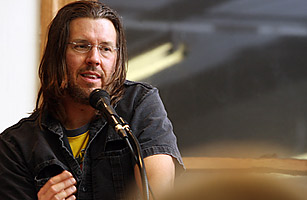
What would you write if you could write absolutely anything? This is the question that, as a reader, one imagined David Foster Wallace facing. Whereas ordinary authors resorted to the standard tricks of the trade–write what you know, look deep into your soul, whatever–Wallace seemed to have no earthly constraints. He knew everything and could look into anybody’s soul he wanted to. Any writer in America would have killed for his talent, but the man to whom it belonged killed himself. On Sept. 12, Wallace’s wife discovered his body at their home in Claremont, Calif. He had hanged himself. He was 46. He was David Foster Wallace only on the page. His first agent suggested that he use his middle name, to distinguish him from another David Wallace, and it stuck. Born in 1962 and raised in Illinois, he was a competitive junior tennis player–at 14 he was ranked 17th in the Midwest. He studied philosophy at Amherst College and then Harvard, and when he was only 24, he published his first novel, The Broom of the System. In 1996 he vaulted into the upper ranks of the literary world with Infinite Jest, his 1,079-page meta-epic of tennis, drug addiction, art, terrorism and loneliness set in a future when each year is known by the name of its corporate sponsor . Infinite Jest was the quintessence of 1990s literary maximalism, and it became instant required reading. Enough with those ’80s party-boy writers! Here was a novelist with the industrial-strength intellectual chops to theorize even our resolutely anti-intellectual age. Wallace became a reluctant literary pinup, with his stubbly outsize chin and his shoulder-length hair. He was America’s No. 1 literary seed, at the top of a hierarchy that was, one suspects, largely meaningless to him. Reading it now, with the burden of hindsight, one sees that Infinite Jest is ominously infested with suicides, including that of the hero’s father, who cooks his own head in a microwave. But back then, Wallace seemed invulnerable. How could a man who had put such crowds of people on the page–Wallace’s ear for dialogue was unmatched in contemporary fiction–truly be lonely? Once you’ve gone inside the mind of a critically burned toddler, as Wallace did in his short story “Incarnations of Burned Children,” what horrors can’t you face? When he accepted a professorship of creative writing at Pomona College in 2002 and then got married in 2004, one imagined that his relentlessly generative genius might finally be undergoing some domestic mellowing. Now we have some idea what it was that he couldn’t face. Since his death, Wallace’s family has stated that he was chronically depressed. He had been taking medication for his condition for 20 years and had occasionally been hospitalized. “Everything had been tried,” his father said, “and he just couldn’t stand it anymore.” What was “it”? In Infinite Jest Wallace wrote–in a passage that now reads like a lucid cell-phone call from the pilot of a crashing 747–that clinical depression is “lonely on a level that cannot be conveyed … Everything is part of the problem, and there is no solution. It is a hell for one.” What Wallace suffered was both agonizing and indescribable, even by him. And that last may have been what made it unbearable. Like Hamlet–who gave Infinite Jest its title–he had that within which passeth show. Even if he could have written on and on, an infinite number of words, it would never have been enough.